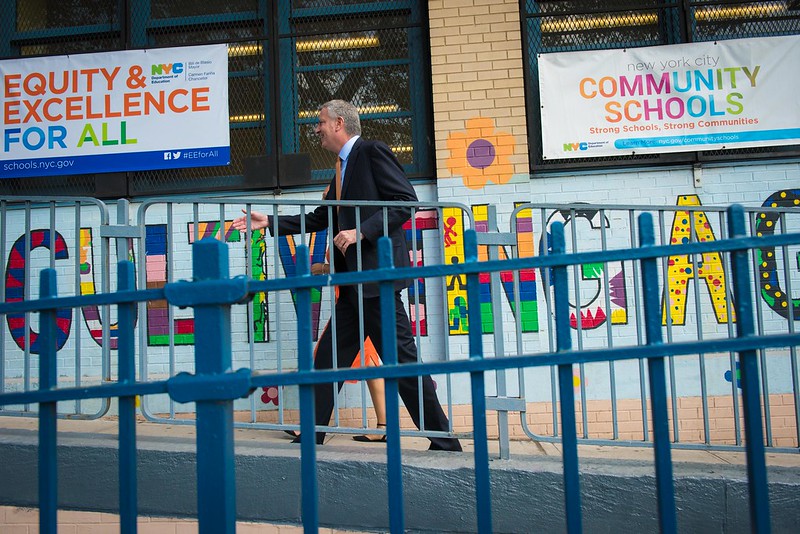
Mayor de Blasio goes to school (photo: Michael Appleton/Mayor's Office)
It was 2014 when Mayor de Blasio declared that “under Carmen Fariña’s leadership, principals and teachers alike have been training and training and training – it’s like they’re all going to the Olympics – they’ve been training all summer to be the best they could be.”
But six years later, the mayor has changed his tune. He’s proposing to slash funding for professional development for the city’s 75,000 educators at a time when children need us most and teachers most need it to serve students in an unprecedented, quickly-changing environment.
Our city is weathering a devastating global pandemic, a transition to remote learning for 1.1 million kids, Great Depression-level unemployment, and corresponding city budget challenges – all as the nation has been shaken to its core by the death of George Floyd.
Amidst these simultaneous crises, kids are looking to teachers to understand this unique moment in history. And yet, despite the Department of Education touting professional development as central to child development over the last six years, educators everywhere are now on the cusp of a massive cut to the training they need.
It’s exactly the wrong thing to do at exactly the wrong time.
Today, of the Department of Education’s $25 billion budget, roughly $500 million goes towards teacher professional development. Now, as it faces a budget shortfall, City Hall plans to cut $67 million of PD – a significant scale-back. Investments in educators are one of the first things on the chopping block.
But the fact is learning should never stop, neither for our kids nor the adults who teach them. Pedagogical mastery is a long-term progression, and halting that mastery during a time of crisis will be felt in classrooms everywhere, especially in the virtual learning age.
Why? Because, at this moment, teachers are being asked to reinvent decades of practice practically overnight, all behind a computer. They’re doing things they’ve never had to do before. With schools expected to adopt a hybrid model of in-person and remote instruction in the fall, virtual classrooms will be with us for months to come.
That means our students will be even more vulnerable if their teachers don’t have the resources to effectively instruct remotely. Learning loss could be catastrophic, and our health crisis could indeed morph into a long-term learning emergency for our city.
We know the antidote, though. It’s investing in teachers. Doubling down on training for educators, especially if officials tailor it for the moment in which we’re living, is not some isolated line item. It’s a deliberate strategy for success.
At my school – Bronx Charter School for the Arts – roughly 82% percent of our elementary students are attending virtual class each day, and professional development has been a key ingredient to our success. Once we overcame the initial challenge of providing devices to students, adapting our lessons to a remote environment was the next hurdle, especially for reading and literacy.
Our curriculum, Units of Study, cultivates collaboration and socialization, while fostering independence. Children analyze characters, develop critical thinking skills, and grasp the big picture of story elements. Those objectives are hard to achieve virtually, but we’ve been reflective practitioners, balancing the needs of the students and our programmatic goals. Working closely with our curricular experts at the Teachers College Reading and Writing Project, we have often revised the work to be responsive. Constant teacher training, and having quality curricular partners, has made distance learning merely a new skill that we’ve mastered – not a permanent roadblock to learning.
Our professional development partners themselves have also pivoted their own programs to meet this moment. The Reading and Writing Project recently ran a virtual Pandemic Institute, which provides lesson plans for teachers that allow their students to become historians of this crisis. Enabling children to make connections between their current day-to-day experiences and their learning is one of the main reasons our attendance numbers are so high.
And at this moment, perhaps more than any other in recent memory, connecting learning to real-time events is critical.
That’s also why cutting professional development citywide is so short-sighted. As a school leader, I recognize the difficult decisions our city leaders have to make right now. But I also know that we don’t want to create long-term pain for a short-term gain. We’ve instructed all of our children to focus on their education. But if teachers do not continue to grow their craft through professional development – especially during these trying times – then policymakers are acting in the opposite manner for which we have advised students all of their young lives.
Teachers are doing heroic work right now, and we need to set them up for continued success.
***
Jonea Thomas is the elementary school principal at Bronx Charter School for the Arts.
***
Have an op-ed idea or submission for Gotham Gazette? Email This email address is being protected from spambots. You need JavaScript enabled to view it.